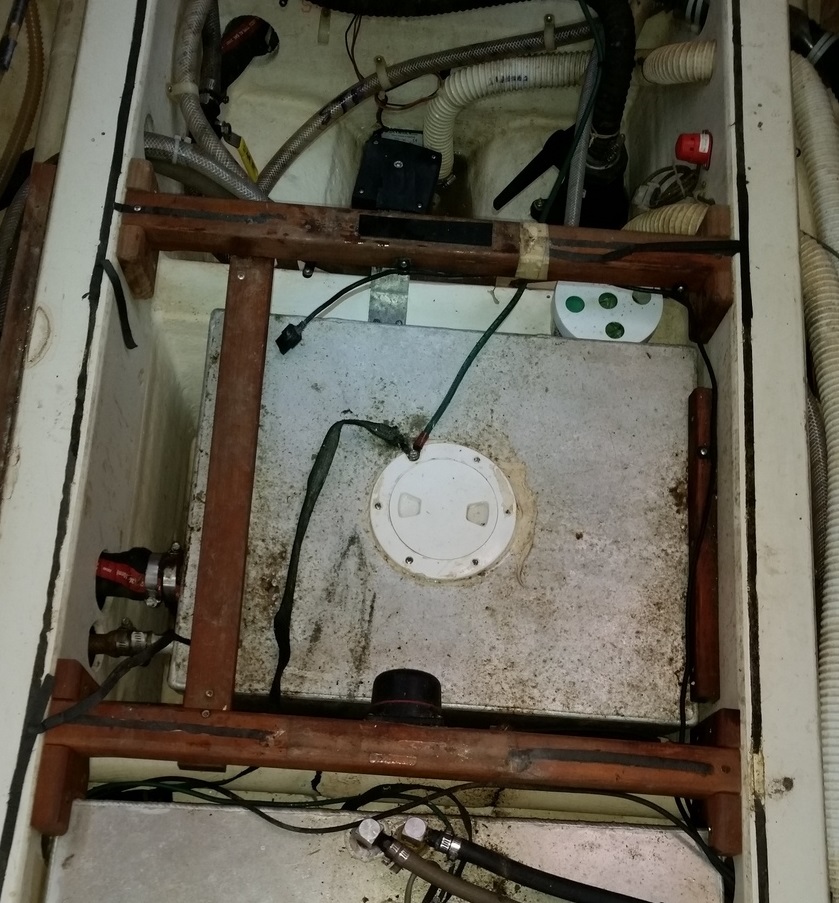When it comes to boat repairs, I am not a very lucky man. My previous two boats have dumped “black water” into the bilge requiring significant repairs and Kinship seems to have been in on the deal and did not want to be left out.
During the survey we tested the holding tank and we did not see any leaks, but we did note the signs of issues and we investigated a replacement tank and planned to replace the tank over the summer. The boat gods had other ideas.
On the delivery trip we noticed some nasty smells coming from the bilge. At the time we had 6 people on board and a fully functional head was on the essential list. We could not establish where the leak was coming from or when it leaked. We pumped out at every opportunity on the trip. Before we got back to Lake Ontario, I placed an order with Ontario Plastics for a tank designed by Mark Tilley, owner of Saving Grace, Saga 43 #40. Mark’s design adds volume by fitting better to the space and adding a slump. The old tank was about 13-14 US Gal, far from the 20 US Gal often quoted, the new one is 16.9 US Gal (63.9l). The slump also improves the emptying of the tank so that very little is left in the tank following a pumpout. The tank was delivered to Kingston a week or so after we arrived at the end of the delivery.
Replacing the tank was a big job and as we had to stay in a hotel rather than on the boat it would likely have been cheaper to have the work done by Zahniser’s before we left on the delivery. That said, I think it is important to fully understand the systems on our boat, I just wish it did not always have to start with this system.
Having carefully empted and rinsed the tank, we removed it and quickly found the source of the leak. Much of the bottom of the tank was corroded and in parts holed. There were a number of pinholes that must have been plugged with sludge when we tested the tank, only to leak when the boat was moving.
Aluminium is not really a sensible material for tanks, least of all holding tanks. I imagine I will be changing the rest of the tanks over time.
We started work on replacing the old hoses and the head so we would have “clean” start. We used the old hoses to pull the new ones into place. In a natural progression, I removed the hose from the macerator pump only to find a broken bolt on the pump head. The executive decision was taken to replace the pump and keep the old one as a spare. Running the hoses was a three person job, the hoses for the head and pumpout run under the head moulding and required pushing, pulling and wiggling in the middle to get them into place.
The new tank went in easily with the thwarts removed. At this stage I worked out the hold down and the runs for the hoses. Once I have this organised I started the assembly process with the tank gauge.
Connecting the hoses was a question of lots of lube and careful use of the heat gun.
Getting the hose onto the deck fitting for the pumpout was a royal pain, I later discovered that there are angled deck fittings that would have reduced the “S” curve.
I reused the hold down from the old tank by removing a spacer below it. The new tank is held in place by the brackets for the thwarts and the hold down. The tank is slightly compressed by the hold down and is very solidly in place. The tank is quite easy to get out to access the aft keel bolts. The tank has the option of a second vent line, which I plan to add over the winter.
I replaced the foam seals in the floor while we had so much of it accessible. The tank monitor panel is located in the head and easily checked sitting on the head.
I am really happy with the end results. The tank monitor really helps reduce the stresses of cruising in no-discharge areas. I am now on the lookout for a good solution to monitor our three water tanks.
